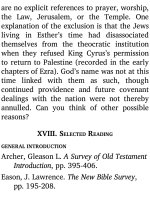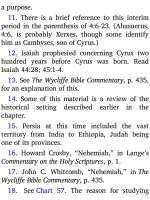Jensens survey of the old testament adam 507
Bạn đang xem bản rút gọn của tài liệu. Xem và tải ngay bản đầy đủ của tài liệu tại đây (152.02 KB, 4 trang )
3. Quoted in J. Sidlow Baxter, Explore the
Book, 6:181.
4. References to the “palace” (1:13) and
“Caesar’s household” (4:22) are evidence
that the letter came from Rome.
5. H.C.G. Moule, Philippian Studies, p. 5.
6. Cf. Henry C. Thiessen, Introductory
Lectures in Systematic Theology, p. 296.
7. John Phillips, Exploring the Scriptures, p.
239.
8. H.C.G. Moule, Philippian Studies, pp. 25354.
16Colossians: Christ Is All and in All
Colossians is another of Paul’s four prison
epistles, similar in many ways to his letter to
Ephesus. The church addressed was very
small and inconspicuous, but the letter itself
had all the credentials of a message from
God. Its readers could not help but notice
that it magni es the Person and work of
Jesus Christ. Those who study the book
today discover new insights into the depths
and riches of intimate fellowship with
Christ, who “is all, and in all” (3:11).
I. PREPARATION FOR STUDY
You have just completed your survey of
Philippians, whose setting and tone are very
di erent from those of Colossians. Prepare
yourself mentally to expect di erences,
keeping in mind that diversity of peoples,
church situations, and experiences brings on
such differences.
Refer to Chart 1, page 20, again and note
when Colossians was written — almost
midway in the writing series of the twentyseven books.
II. BACKGROUND
A. AUTHOR AND DESTINATION
Colossians 1:1 identi es the author as
Paul, and recognizes Paul’s co-worker
Timothy in its greeting. Verse 2 identi es
the readers as “the saints and faithful
brethren in Christ who are at Colossae.”
Paul also directed the Colossian church to
share the letter with the church at Laodicea
(4:16; cf. 2:1). The title of the book,
“Colossians,”
is
derived
from
the
destination.
B. THE CITY OF COLOSSAE
See Map U (Environs of Colossae) and
note that Colossae was one of the “tri-cities”
of the Lycus Valley. This area was about one
hundred miles inland from Ephesus. (See
also Map V for the larger setting.) Five
centuries before Christ, Colossae was hailed
as “the great city of Phrygia.” By Paul’s
time, it was just a small town. A main reason
for the change was the rise of the
neighboring
cities of Laodicea and
Hierapolis, when the trade route between
Ephesus and the Euphrates Valley was
diverted away from Colossae.1









